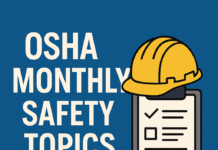
OSHA 510 vs OSHA 30: Understanding the Differences
When it comes to workplace safety and compliance, two certifications stand out: OSHA 510 and OSHA 30. Both are crucial for professionals aiming to enhance their knowledge of occupational safety and health standards. However, understanding the nuances and disparities between these certifications is vital for choosing the right path for one’s career advancement.
1. Introduction to OSHA 510 and OSHA 30
Occupational Safety and Health Administration (OSHA) certifications are recognized worldwide as benchmarks of expertise in workplace safety regulations and practices. OSHA 510 and OSHA 30 are two distinct certifications tailored for different audiences and objectives.
2. Understanding OSHA 510 Certification
What is OSHA 510?
OSHA 510 is a course designed for individuals responsible for implementing and maintaining workplace safety programs. It provides comprehensive knowledge of OSHA standards, policies, and procedures, enabling participants to identify and mitigate potential hazards effectively.
Who should take OSHA 510?
OSHA 510 is ideal for safety professionals, supervisors, and managers seeking in-depth training on OSHA regulations. It is particularly beneficial for those involved in construction, manufacturing, and other high-risk industries.
Course content of OSHA 510
The curriculum of OSHA 510 covers a wide range of topics, including hazard recognition, injury prevention, recordkeeping, and safety management systems. Participants undergo rigorous training sessions, simulations, and case studies to develop practical skills for ensuring workplace safety.
3. Insight into OSHA 30 Certification
What is OSHA 30?
OSHA 30 is an intensive training program aimed at educating workers and supervisors on occupational safety and health hazards. It provides a broad overview of OSHA regulations and best practices for maintaining a safe work environment.
Target audience for OSHA 30
OSHA 30 is suitable for frontline workers, supervisors, and entry-level safety personnel across various industries. It equips participants with essential knowledge and skills to recognize, evaluate, and control workplace hazards effectively.
Curriculum covered in OSHA 30
The OSHA 30 curriculum encompasses topics such as fall protection, electrical safety, hazardous materials handling, and emergency response procedures. It emphasizes hands-on training and real-life scenarios to ensure participants are well-prepared to address safety challenges in their respective fields.
4. Key Differences between OSHA 510 and OSHA 30
Duration and intensity
OSHA 510 typically requires a longer time commitment, ranging from one to two weeks of intensive training. In contrast, OSHA 30 is usually completed over a period of four days, with less emphasis on in-depth analysis and more focus on practical applications.
Focus areas
While OSHA 510 delves deep into regulatory compliance and safety management systems, OSHA 30 provides a broader overview of workplace hazards and preventive measures. OSHA 510 is geared towards professionals with managerial responsibilities, whereas OSHA 30 targets frontline workers and supervisors.
Certification objectives
OSHA 510 certification demonstrates a higher level of expertise in safety program implementation and compliance management. It is often a prerequisite for advanced roles in safety management and consultancy. On the other hand, OSHA 30 certification signifies a basic understanding of OSHA regulations and serves as a foundation for entry-level positions in various industries.
5. Advantages of OSHA 510 Certification
Career prospects
Obtaining OSHA 510 certification enhances career prospects for safety professionals, opening doors to higher-paying job opportunities and managerial roles. Employers value individuals with advanced knowledge of safety regulations and risk management strategies.
Enhanced safety knowledge
OSHA 510 equips participants with specialized skills for identifying workplace hazards, conducting safety audits, and implementing effective control measures. It fosters a culture of safety awareness and empowers professionals to proactively address safety challenges in diverse work environments.
Regulatory compliance
By completing OSHA 510 training, organizations demonstrate their commitment to regulatory compliance and employee welfare. Certified professionals play a crucial role in ensuring workplace safety standards are met and maintained, reducing the risk of accidents and legal liabilities.
6. Benefits of OSHA 30 Certification
Broad applicability
OSHA 30 certification is widely recognized across industries, making it a valuable asset for individuals seeking employment opportunities in diverse sectors. It provides a solid foundation of safety principles and practices applicable to various work environments.
Practical approach to safety
OSHA 30 emphasizes hands-on training and practical exercises, enabling participants to apply theoretical knowledge in real-world scenarios. It fosters critical thinking skills and problem-solving abilities essential for effectively addressing safety concerns and preventing accidents.
Industry recognition
Employers value OSHA 30 certification as evidence of a candidate’s commitment to workplace safety and regulatory compliance. It enhances credibility and trustworthiness, distinguishing certified professionals as competent and reliable assets to their organizations.
7. Choosing Between OSHA 510 and OSHA 30
Career goals and aspirations
Individuals should consider their long-term career goals and aspirations when deciding between OSHA 510 and OSHA 30. If aiming for managerial positions or specialized roles in safety consulting, OSHA 510 may be the preferred choice. However, if seeking entry-level positions or frontline roles with a focus on practical safety measures, OSHA 30 is more suitable.
Industry requirements
The specific requirements and expectations of the industry should also influence the decision-making process. Some sectors may prioritize OSHA 510 certification for regulatory compliance and risk management purposes, while others may value the practical skills and foundational knowledge imparted by OSHA 30 training.
Personal learning preferences
Lastly, individuals should consider their preferred learning style and ability to commit to the duration and intensity of each certification program. Those who thrive in structured, classroom-based environments may excel in OSHA 510 training, whereas others may prefer the flexibility and hands-on approach of OSHA 30.
OSHA 510 and OSHA 30 are both training courses offered by the Occupational Safety and Health Administration (OSHA) in the United States, but they serve different purposes and target different audiences.- OSHA 30: This is a comprehensive safety training course designed for supervisors, managers, and other personnel with safety responsibilities in their workplaces. It covers a wide range of topics related to occupational safety and health, including hazard recognition, avoidance, and prevention. OSHA 30 is typically a 30-hour course, hence the name.
- OSHA 510: This course, on the other hand, is specifically geared towards individuals who want to become authorized OSHA Outreach Trainers in the construction industry. It focuses on the OSHA standards for the construction industry and includes topics such as hazard identification, control measures, and OSHA policies and procedures. OSHA 510 is a prerequisite for becoming an OSHA Outreach Trainer.
In summary, OSHA 30 is a general safety course aimed at supervisors and managers, while OSHA 510 is a specialized course for individuals seeking to become authorized OSHA Outreach Trainers in construction.8. Conclusion
In conclusion, OSHA 510 and OSHA 30 are both valuable certifications for professionals seeking to enhance their expertise in workplace safety and regulatory compliance. While OSHA 510 offers in-depth training for safety management professionals, OSHA 30 provides a broad overview of safety principles for frontline workers and supervisors. Choosing the right certification depends on individual career goals, industry requirements, and learning preferences. Ultimately, both certifications serve to promote a culture of safety and protect the well-being of workers in various industries.
Top 10 OSHA Violations in 2024
FAQs
- Is OSHA 510 more challenging than OSHA 30?
- OSHA 510 is generally considered more challenging due to its intensive curriculum and focus on regulatory compliance and safety management systems.
- Can I take OSHA 30 online?
- Yes, OSHA 30 training is available online, allowing participants to complete the course at their own pace and convenience.
- Are OSHA 510 and OSHA 30 certifications internationally recognized?
- Yes, both OSHA 510 and OSHA 30 certifications are recognized globally as evidence of proficiency in workplace safety standards and practices.
- Do I need prior experience to enroll in OSHA 510 or OSHA 30?
- No prior experience is required for either certification. Both OSHA 510 and OSHA 30 cater to individuals with varying levels of expertise in occupational safety and health.
- How often do I need to renew my OSHA 510 or OSHA 30 certification?
- OSHA 510 and OSHA 30 certifications are valid for five years. Renewal courses are available to update participants on any changes to OSHA regulations and maintain certification status.
























